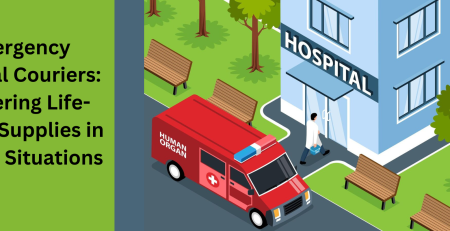Enhancing Efficiency and Patient Care: The Role of Collaboration in Healthcare Delivery between Medical Couriers and Healthcare Facilities
Arrived EZ2024-02-03T18:44:59+00:00In the dynamic landscape of healthcare delivery, seamless collaboration between medical couriers and healthcare facilities plays a pivotal role in ensuring the efficient and timely transportation of medical supplies, specimens, and equipment. This synergy not only optimizes operational workflows but also contributes to elevated patient care standards. In this blog, we delve into the significance of collaboration in healthcare delivery and how the partnership between medical couriers and healthcare facilities can lead to enhanced outcomes.
The Need for Collaboration in Healthcare Delivery:
The efficient delivery of healthcare services depends significantly on the smooth and coordinated functioning of various elements within the healthcare ecosystem. One critical aspect that plays a pivotal role in this process is the collaboration between medical couriers and healthcare facilities. This partnership is essential in addressing several challenges associated with the transportation of medical goods, which include supply chain management, specimen transport, and medical equipment distribution.
Supply Chain Management:
Timely Delivery: Medical couriers play a crucial role in ensuring the timely and accurate delivery of pharmaceuticals, medical supplies, and other essential materials to healthcare facilities. This is particularly vital in preventing stock outs and ensuring that healthcare providers have access to the necessary resources to deliver quality patient care.
Temperature-sensitive Items: Certain medical supplies, such as vaccines or certain medications, may be temperature-sensitive. Medical couriers with specialized equipment can ensure that these items are transported under the required conditions, maintaining their efficacy and integrity.

Specimen Transport:
Quick and Secure Transport: The transportation of medical specimens, such as blood samples or tissues, is time-sensitive. Medical couriers are equipped to handle these delicate materials with care, ensuring their swift and secure transport from one location to another. This is critical for diagnostic purposes, allowing healthcare providers to receive test results promptly.
Medical Equipment Distribution:
Efficient Deployment: Medical facilities often need to distribute and deploy various types of medical equipment promptly. This includes everything from diagnostic machines to patient monitoring devices. Collaborating with medical couriers ensures that these critical tools reach their destinations efficiently, contributing to the seamless operation of healthcare facilities.
Emergency Situations:
Rapid Response: In emergency situations or during crises, the need for prompt delivery of medical supplies, equipment, and specimens becomes even more crucial. The collaboration between medical couriers and healthcare facilities enables a rapid response system, helping healthcare providers address urgent situations with the necessary resources at their disposal.
Cost Efficiency:
Specialized Services: Outsourcing transportation services to specialized medical couriers can often be more cost-effective for healthcare facilities. These couriers have the expertise and infrastructure to handle medical goods efficiently, allowing healthcare providers to focus on their core responsibilities without the added burden of managing complex logistics.
In conclusion, the partnership between medical couriers and healthcare facilities is fundamental to achieving an efficient and effective healthcare delivery system. It not only addresses logistical challenges but also ensures that healthcare providers can focus on their primary mission of delivering high-quality patient care. This collaboration contributes to the overall resilience and responsiveness of the healthcare ecosystem, particularly in times of increased demand or emergencies.
Key Benefits of Collaboration:
Timely and Secure Specimen Transport:
The role of medical couriers in ensuring the safe and prompt delivery of specimens from healthcare facilities to laboratories is crucial for facilitating timely diagnoses and treatment planning. This process involves several key elements that contribute to the overall effectiveness of healthcare services:
Timely and Efficient Transport:
Medical couriers specialize in the swift and secure transport of various medical specimens, including blood samples, tissues, and other diagnostic materials. Timeliness is of the essence, particularly when it comes to diagnostic testing, as quick delivery ensures that laboratories can begin analysis promptly, leading to faster results.
Preservation of Specimen Integrity:
Maintaining the integrity of specimens is paramount for accurate diagnostic outcomes. Medical couriers employ specialized packaging and handling procedures to ensure that specimens are protected from environmental factors such as temperature fluctuations, vibrations, and exposure to contaminants. This safeguards the quality of the samples during transit.
Adherence to Transportation Regulations:
Medical couriers operate in strict adherence to transportation regulations and protocols set by healthcare authorities. Compliance with these guidelines is essential to guarantee the safety and reliability of the specimens during transportation. This includes proper labelling, documentation, and adherence to specific handling procedures for different types of specimens.
Minimization of Contamination and Deterioration Risks:
Strict adherence to transportation protocols minimizes the risk of specimen contamination or deterioration during transit. Couriers are trained to handle specimens with care, utilizing appropriate containers and packaging to prevent leaks or spills. This attention to detail helps maintain the stability and viability of the specimens until they reach the laboratory.

Specialized Training for Couriers:
Medical couriers often undergo specialized training to handle medical specimens safely. This training encompasses proper specimen identification, handling procedures, and emergency response protocols. Couriers are equipped to address any unforeseen challenges that may arise during transit, ensuring the specimens remain viable for accurate testing.
Communication and Tracking Systems:
To enhance transparency and accountability, medical couriers often employ advanced communication and tracking systems. This allows healthcare facilities and laboratories to monitor the status and location of specimens in real-time. In case of any delays or issues, prompt communication ensures that corrective measures can be taken to minimize potential disruptions.
Customer Service and Responsiveness:
Medical couriers prioritize customer service and responsiveness. Effective communication channels between couriers, healthcare facilities, and laboratories help address any concerns or special requirements. This collaborative approach ensures that the entire process runs smoothly and that healthcare providers can rely on timely and accurate diagnostic results.
In summary, the meticulous handling and transportation of specimens by medical couriers contribute significantly to the healthcare ecosystem. Their commitment to following regulations, utilizing specialized training, and employing advanced tracking systems ensures the safe and efficient delivery of specimens. This, in turn, supports healthcare professionals in making timely diagnoses and developing appropriate treatment plans for patients.
Optimized Supply Chain Management:
Collaboration between healthcare facilities and their supply chain partners, including medical couriers and suppliers, plays a pivotal role in streamlining the supply chain process. This collaboration introduces several benefits that enhance efficiency and reduce the risk of disruptions:
Real-time Tracking and Monitoring:
Collaboration enables the implementation of real-time tracking and monitoring systems for medical supplies during transit. With advanced technology and communication platforms, healthcare facilities can track the movement of supplies from the point of origin to their doorstep. This real-time visibility helps in anticipating delivery times, allowing for better planning and reducing the risk of stock outs or delays.
Proactive Inventory Management:
Real-time tracking data allows healthcare facilities to adopt a proactive approach to inventory management. By knowing the exact location and status of incoming supplies, healthcare administrators can make informed decisions about when to expect deliveries and how to allocate resources efficiently. This helps in maintaining optimal stock levels to meet the demand and avoid unnecessary shortages or overstock situations.
Risk Mitigation:
The ability to monitor the supply chain in real-time facilitates early identification of potential issues or disruptions. Whether it’s a delay in transportation or a sudden increase in demand, healthcare facilities can respond proactively to mitigate risks. This proactive approach is especially critical in preventing stock outs of essential medical supplies, and ensuring continuous and uninterrupted patient care.
Improved Communication:
Collaboration involves effective communication channels between healthcare facilities and their supply chain partners. Timely updates on inventory levels, delivery schedules, and any unforeseen challenges enable better coordination. This open line of communication fosters a collaborative environment, allowing for quick problem-solving and adjustments to ensure the smooth flow of medical supplies.
Reduced Administrative Burden:
Automated systems that are integrated into the collaboration process help reduce the administrative burden on healthcare staff. Instead of manually tracking and managing inventory, automated systems can provide real-time updates and alerts, allowing healthcare professionals to focus on patient care and strategic decision-making rather than tedious administrative tasks.
Challenges in Same-Day Delivery: Roadblocks to Reliability
Logistical Hurdles
Implementing same-day delivery can be a competitive advantage for businesses, but it comes with its own set of logistical hurdles. Overcoming these challenges is crucial to providing a seamless and reliable service. Here are some common logistical hurdles associated with same-day delivery:
Order Processing Time:
Challenge: Efficiently processing orders in real-time can be challenging, especially during peak hours.
Solution: Implement automated order processing systems to streamline the workflow and reduce manual errors.
Optimized Stock Levels and Reduced Waste:
Collaboration, coupled with automated systems, facilitates data-driven decision-making in inventory management. By analyzing historical data, consumption patterns, and real-time demand, healthcare facilities can optimize their stock levels. This precision helps in reducing waste by avoiding overstocking or expiration of medical supplies, ultimately contributing to cost-effectiveness and sustainability.
Efficient Resource Allocation:
Real-time information on supply chain dynamics allows healthcare facilities to allocate resources more efficiently. This includes not only medical supplies but also human resources. With a clearer understanding of when supplies are expected to arrive, healthcare administrators can optimize staffing levels to handle the incoming inventory and ensure that the necessary personnel are available for receiving, inspecting, and distributing supplies.
In conclusion, collaboration in the healthcare supply chain, enhanced by real-time tracking and automated systems, brings about a more efficient and responsive system. This approach helps healthcare facilities maintain optimal stock levels, reduce the risk of stockouts, and enhance overall resource management. As a result, healthcare professionals can focus on delivering quality patient care without the disruptions caused by inadequate or excessive supplies.
Improved Patient Care and Experience:
The faster delivery of critical medical supplies and equipment, facilitated by efficient collaboration between healthcare facilities and their supply chain partners, has significant implications for emergency response and overall patient outcomes. This collaboration contributes to quicker response times during emergencies, positively impacting patient care in the following ways:
Timely Emergency Response:
In emergencies, time is of the essence. Efficient collaboration ensures that critical medical supplies and equipment, such as life-saving medications, trauma equipment, or specialized devices, reach healthcare facilities promptly. This swift response can be crucial in stabilizing patients and initiating necessary interventions, ultimately improving the chances of positive outcomes.
Reduced Treatment Delays:
Faster delivery of medical supplies and equipment minimizes delays in treatment. Whether it’s responding to a mass casualty event, a natural disaster, or an influx of patients during a public health crisis, timely access to essential resources allows healthcare providers to initiate treatment protocols without unnecessary delays. This can be particularly vital in situations where every minute counts, such as in the case of cardiac emergencies or severe trauma.
Enhanced Preparedness for Surges in Demand:
Efficient collaboration ensures that healthcare facilities are better prepared to handle surges in demand during emergencies. By having streamlined supply chain processes in place, facilities can quickly scale up their resources to meet increased patient needs. This adaptability is crucial in maintaining a high standard of care even under challenging circumstances.
Improved Patient Outcomes:
Quicker response times and reduced treatment delays directly contribute to improved patient outcomes. Whether it’s administering life-saving medications, performing emergency procedures, or providing critical care interventions, having the right supplies on hand in a timely manner can make a significant difference in the recovery and survival rates of patients.


Minimized Disruptions in Healthcare Services:
Efficient collaboration helps minimize disruptions in healthcare services during emergencies. By ensuring a constant and reliable supply of medical goods, healthcare facilities can continue to operate smoothly even in the face of unexpected challenges. This resilience is essential in maintaining essential healthcare services and preventing unnecessary hardships for patients.
Enhanced patient satisfaction:
Timely access to medical supplies and equipment contributes to a positive patient experience. Patients and their families are reassured when they see that healthcare providers have the necessary resources readily available to address their needs. This level of preparedness and responsiveness enhances overall patient satisfaction, fostering trust in the healthcare system.
Building Trust in Healthcare Systems:
Consistent and efficient collaboration builds trust in healthcare systems. When patients and the community witness a well-coordinated response to emergencies, it instils confidence in the healthcare system’s ability to handle crises effectively. This trust is crucial for community engagement, compliance with healthcare recommendations, and overall public health outcomes.
In conclusion, the faster delivery of critical medical supplies and equipment through efficient collaboration is a key factor in improving emergency response times and positively impacting patient outcomes. This not only ensures a higher level of preparedness but also contributes to patient satisfaction and trust in the healthcare system, ultimately strengthening the overall resilience of the healthcare ecosystem.
Cost-Efficiency and Resource Optimization:
Collaborative efforts lead to cost savings through streamlined logistics, reduced transportation costs, and minimized waste in supply chain processes.
Shared resources and logistics infrastructure contribute to a more sustainable and cost-effective healthcare delivery model.
Successful Collaboration Strategies:
Integrated Technology Solutions:
Implementing advanced tracking and monitoring systems ensures real-time visibility of medical shipments, fostering transparency and accountability.
Cloud-based platforms facilitate seamless communication between healthcare facilities and medical couriers, enabling efficient coordination.
Compliance and Quality Assurance:
Establishing clear protocols and standard operating procedures ensures compliance with regulatory requirements.
Regular audits and quality checks contribute to the continuous improvement of collaborative processes.
Training and Communication:
Conducting joint training sessions for medical couriers and healthcare facility staff enhances understanding and collaboration.
Open and clear communication channels foster a collaborative environment, allowing for quick issue resolution and process optimization.
The collaboration between medical couriers and healthcare facilities is a strategic imperative for the modern healthcare landscape. By optimizing supply chain management, ensuring secure specimen transport, and enhancing overall efficiency, this partnership contributes to elevated patient care standards and improved healthcare outcomes. As the healthcare industry continues to evolve, fostering strong collaborations between stakeholders will be essential for achieving sustainable and patient-centric healthcare delivery.












Leave a Reply